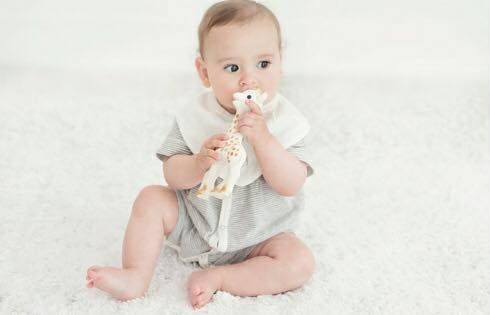Sophie the Giraffe, a $30 teething toy beloved by babies, became public enemy No. 1 for parents this week.

It all started when Dana Chianese, a pediatric dentist and mother of two, went to clean her son’s rubber teether and got a whiff of a musty smell wafting from the tiny hole that’s meant to let air in and out of the squeezable toy.
Chianese sliced open the giraffe and found, according to what she told Good Housekeeping this week, a “science experiment” growing inside.
“Smelly, ugly mould living in my infant’s favourite chew toy.”
A wave of dissections ensued. As parents took knives and scissors to their child’s expensive toy, some were mortified to see the inside was, in fact, infected with black spores.
It’s not the first time
Similar discoveries were previously shared in a February 2016 Amazon review, and in a March 2015 post on the mommy blog What to Expect.
In the latter, the mould was noticed after the mom cut off the giraffe’s legs, which some parents have claimed their children nearly choked on. One U.K. mom wrote on Facebook that “one of Sophie’s legs lodged” in her daughter’s throat, as Yahoo reported in July 2015. Her mother managed to “unhook” the leg and pull it out as the girl was turning blue.
Deborah Gilboa, a family physician, told Yahoo that parents should avoid any toy that can extend more than an inch into a child’s mouth to minimize the risk of choking. Sophie the Giraffe’s legs are two to three inches long.
Global News contacted the company about the most recent controversy but have not heard back. However, the giraffe’s makers have sounded off on social media, saying the issue boils down to proper care.
“The cleaning instructions have to be carefully followed,” the company wrote on its Facebook page on Tuesday.
It stressed that, “as indicated on the packaging and in an explanatory leaflet,” the teether should only be cleaned with a damp cloth. It should never be immersed in water to prevent liquid from getting inside the hole and causing “damage.”
Chianese insists she always followed those instructions. Same with Stephanie Oprea, who posted the Amazon review describing how the inside of her baby’s giraffe was “coated with black mould.” She elaborated on it further this week, claiming she spot cleaned the toy as per the directions.
What do health experts say?
It’s “highly likely” a child will inhale mould spores if they’re inside a teething toy, germ expert Jason Tetro tells Global News.
However, he and other health experts don’t believe there’s much cause for concern.
“Mould is all around us,” Australian immunologist Richard Loh explained to BBC. “If your child is in the park, picking up leaves and bits of grass, licking them and chewing them, there’ll be mould there. We encounter mould a lot and in general we do not get ill.”
One exception is if your child has a pre-existing immune issue (like cancer), or an allergy to mould, which is believed to be rare.
“Allergies to mould look like most other allergies,” pediatrics professor Saul Hymes told NBC News. “There could be red eyes, a lot of sneezing, and even a rash if the allergy is severe enough.”
Any hollow toy that’s rubber or plastic, Hymes added, can grow mould. Parents should especially watch out for bath toys and sippy cups. Mould and even fecal matter have been found in them before.
WATCH: 10 of the worst and most dangerous toys, according to a consumer watch group
Tetro says a regular sniff test will go a long way to keeping toys mould-free.
“Trust your nose,” he said.
“It’ll smell off … It’s hard to describe a mouldy smell, but I think anyone who’s ever smelled a mouldy towel or a mouldy slice of bread knows what that smells like.”
If a toy does start to smell “funky,” and the cleaning instructions allow, give it a good wash in hot soapy water or a 10 per cent bleach solution. If you use bleach, Tetro says to give it at least three good rinses.
Michael Dickinson, a pediatrician in Miramichi, N.B., says any toy that’s getting wet regularly should probably have a shorter shelf life.
“After a year, it’s probably served its purpose.”
He’s more worried about keeping kids under the age of three (who put everything in their mouths) away from toys with small or loose parts. Toys with tiny batteries or magnets can also “wreak havoc” on their intestines, Dickinson said.
WATCH: Medical groups want you to get rid of your backyard trampoline
Health Canada wasn’t able to offer a comment on Sophie the Giraffe specifically, but the agency encourages parents to report any toy concerns. It also shared its stance on products meant to be put in babies’ mouths.
Teething necklaces, for example, should never be tied around a child’s neck due to risk of strangulation. Baby bottles and pacifiers should be regularly inspected for wear and tear as broken or loose pieces can become choking hazards.
Health Canada recommends replacing pacifiers every two months.
“Be cautious,” added Dickinson, “and use common sense.”


Comments